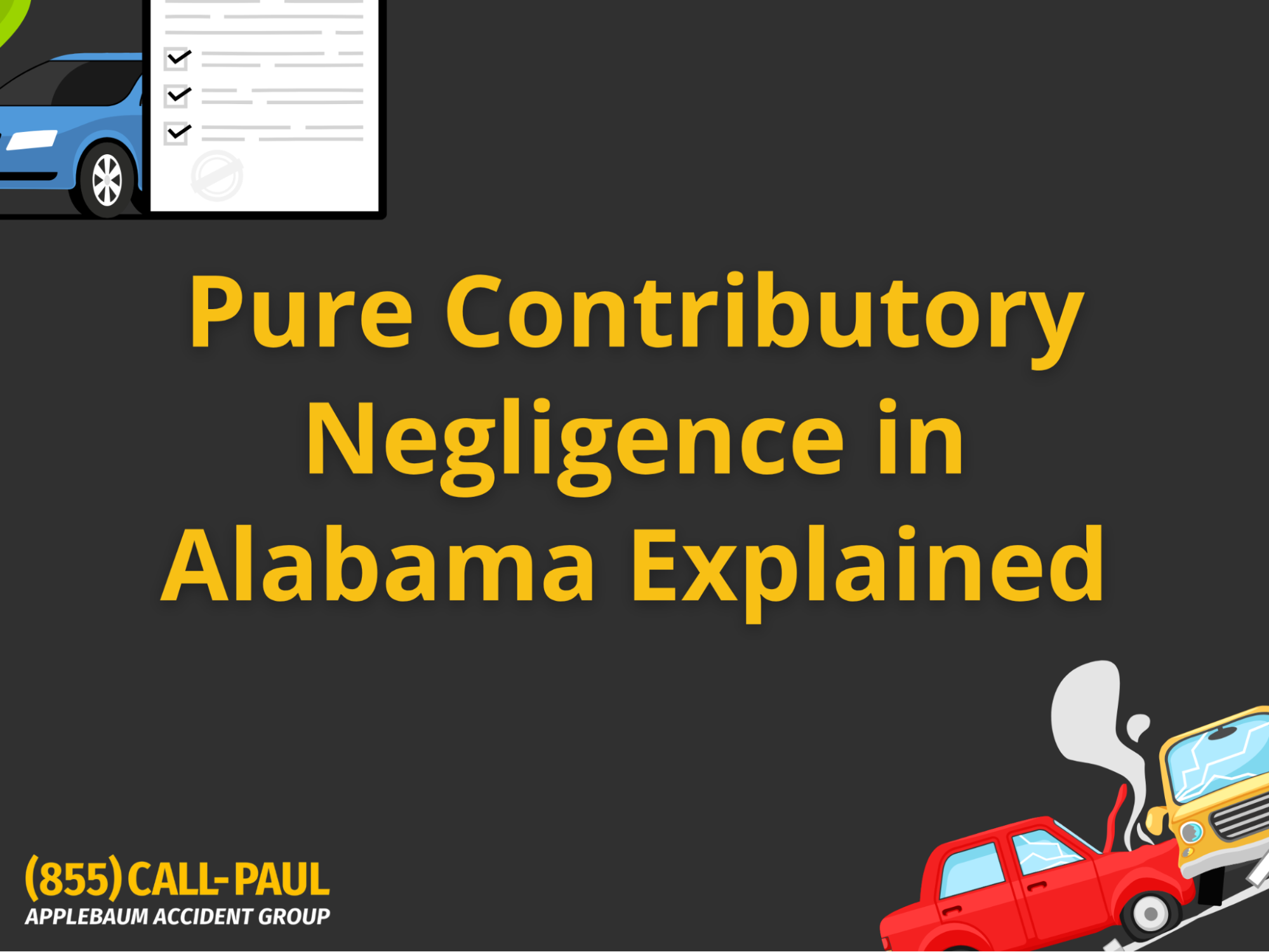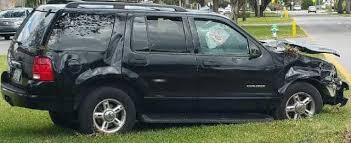Yes, Alabama is a pure contributory negligence state. This means if you’re found even 1% at fault in an accident, you cannot recover any damages. This rule applies to most personal injury cases in Alabama, making it one of the strictest legal standards in the country.
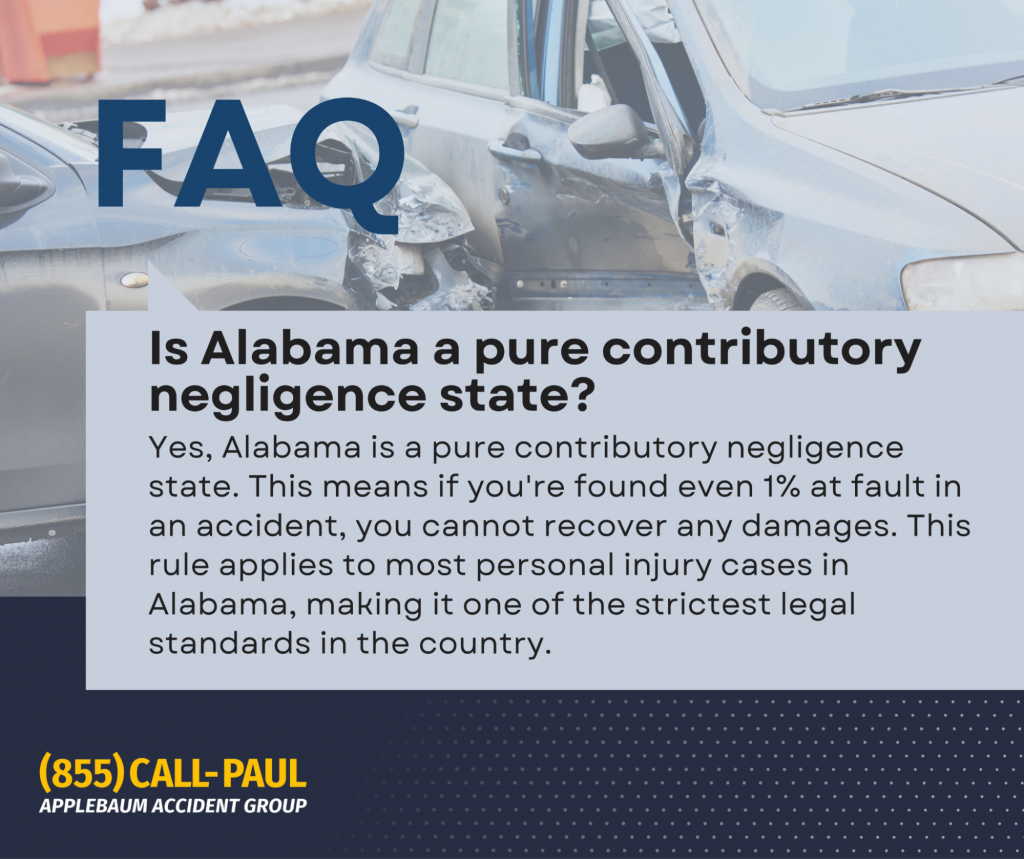
In Alabama, even a tiny misstep, like forgetting your turn signal or crossing at the wrong time, can cost you your entire injury settlement.
That’s because Alabama is one of only four U.S. states that still follow the “pure contributory negligence” rule. If you’re found even slightly responsible for your accident, you walk away with nothing.
That means even a small mistake, like not using your turn signal, jaywalking, or apologizing at the scene, can wipe out your entire claim. The implications are huge, especially when insurance companies aggressively look for any excuse to deny a payout. It’s not just about what happened; it’s about how fault is framed and proven.
At Applebaum Accident Group, we connect car accident victims with attorneys who understand how to fight and win under Alabama’s outdated negligence laws.
Our network was built specifically to help people like you navigate unfair systems, because we’ve seen firsthand how quickly good people get taken advantage of.
This article breaks down what that means for you, how the rule works, and most importantly, how to protect yourself from losing a valid claim.
What Is Pure Contributory Negligence?
Pure contributory negligence is a legal doctrine that blocks a plaintiff from recovering any damages if they’re found even 1% at fault for their injuries. Unlike comparative negligence, where damages are reduced based on your degree of fault, Alabama’s system offers no gray area. It’s all or nothing.
Example:
If you’re 1% at fault in Alabama, you get $0. But in a comparative fault state like Florida, if you’re 1% at fault, you’d still recover 99% of your damages. This makes Alabama one of the most unforgiving states for injury victims.
States using this rule:
- Alabama
- Maryland
- Virginia
- North Carolina
Legal professionals across the country view pure contributory negligence as outdated and unjust. Yet Alabama continues to enforce it. The rationale? Tradition, conservative legal culture, and strong insurer lobbying. The result? Everyday people get shortchanged, especially in car accidents where fault isn’t black and white.
Is Alabama a Pure Contributory Negligence State?
Yes. Alabama is a pure contributory negligence state and has remained so despite decades of legal criticism.
While most of the country transitioned to comparative fault models, where fault is shared proportionally, Alabama has held firm. This standard has its roots in older common law principles, and the legislature has shown little momentum to change it. The legal system here has opted to protect defendants (often insurers and corporations) at the expense of injured individuals.
Many wonder why only a few Mid-Atlantic and Southern states cling to this rule. The answer boils down to legal inertia and political resistance to tort reform. In Alabama, this often means a plaintiff who’s seriously injured might still walk away with nothing.
Elements of Negligence in Alabama
For any personal injury case, the plaintiff must prove four things:
- Duty of Care: The defendant had a legal responsibility to act with reasonable care.
- Breach of Duty: That duty was violated, either by action or inaction.
- Causation: The breach directly caused the injury or loss.
- Damages: The plaintiff suffered measurable harm, physical, emotional, or financial.
But in Alabama, proving these elements isn’t enough. If the defendant can show you were even slightly negligent during this sequence, say, by speeding a little or failing to yield, your claim evaporates.
Jury instructions in Alabama emphasize this: any contributory fault by the plaintiff bars recovery. That means trial attorneys must build a fault-proof narrative, an incredibly high standard compared to most states.
Why 1% Can Ruin Your Claim
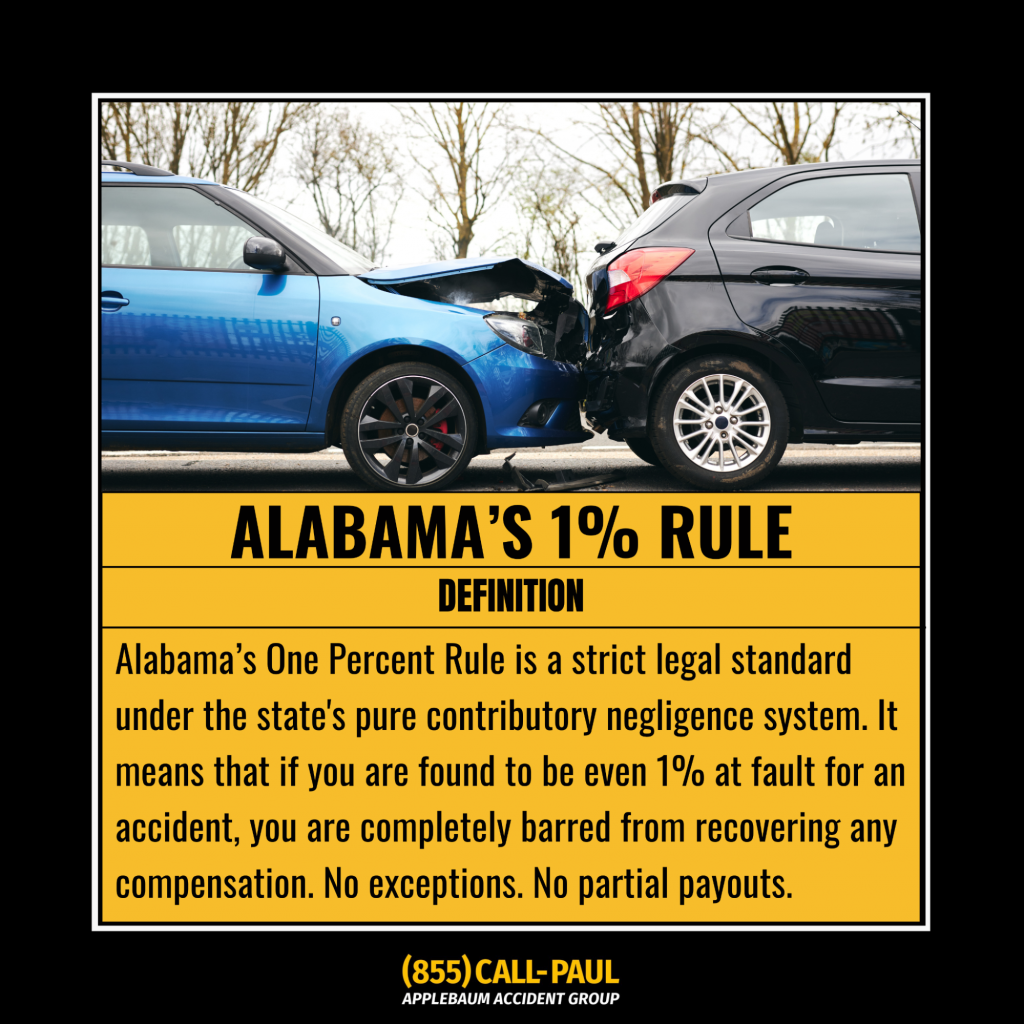
Alabama’s rule is brutal in practice. Here’s how a sliver of perceived fault can derail everything:
- Didn’t wear a seatbelt? You could be seen as partially responsible for your own injuries.
- Said “I’m sorry” at the scene? That can be twisted into an admission of guilt.
- Crossed outside a crosswalk? Even if the driver was speeding, you might be blocked from recovering anything.
Insurance companies in Alabama know this rule, and they use it to their advantage. Their adjusters are trained to ask the right questions, dig through social media, and find any detail that shifts 1% of fault onto you.
- Can your Instagram post hurt your case? Absolutely. If it shows you being active or contradicts your injury claim, even slightly, it can be used as evidence of contributory negligence.
This is why victims often feel blindsided. They didn’t realize one minor act, one casual statement, could be weaponized against them. And it’s why you need strategic legal representation from the start.
How Insurers Weaponize Contributory Negligence
Insurance companies in Alabama rely on angles. The pure contributory negligence standard gives them leverage, and they use it aggressively. Their tactics include:
- Misusing Statements: Casual comments like “I didn’t see them coming” or “I was running late” can be reframed as admissions of fault.
- Highlighting Minor Violations: Failing to signal, jaywalking, or going slightly over the speed limit can become the focus of your case, not the other driver’s behavior.
- Ignoring Context: Even if your behavior was reasonable under the circumstances, insurers may isolate it to assign blame.
This leads many injury victims to ask: “Will the insurer blame me even if I did nothing wrong?” The answer, unfortunately, is often yes. And unless you have legal support, it’s your word against a system designed to doubt you.
Exceptions to Alabama’s Contributory Negligence Rule
Though strict, the rule does have exceptions:
- Minors Under 14: Children are presumed incapable of contributory negligence.
- Mentally Impaired Plaintiffs: Those with cognitive impairments may be exempt depending on medical and legal findings.
- Wanton or Reckless Conduct by Defendant: If the defendant’s behavior was egregious or intentional, contributory negligence may not apply.
- Sudden Emergency Doctrine: If you were responding to an unexpected emergency and acted reasonably under pressure, this can override the negligence finding.
- Last Clear Chance Doctrine: This narrow exception applies when the defendant had the final opportunity to avoid the accident but failed to act.
- Example: A pedestrian steps into traffic illegally but the driver sees them in time and does nothing. If proven, the driver may still be liable despite the pedestrian’s initial fault. Still, this doctrine is rarely successful due to the high burden of proof.
How to Protect Yourself (Step-by-Step)
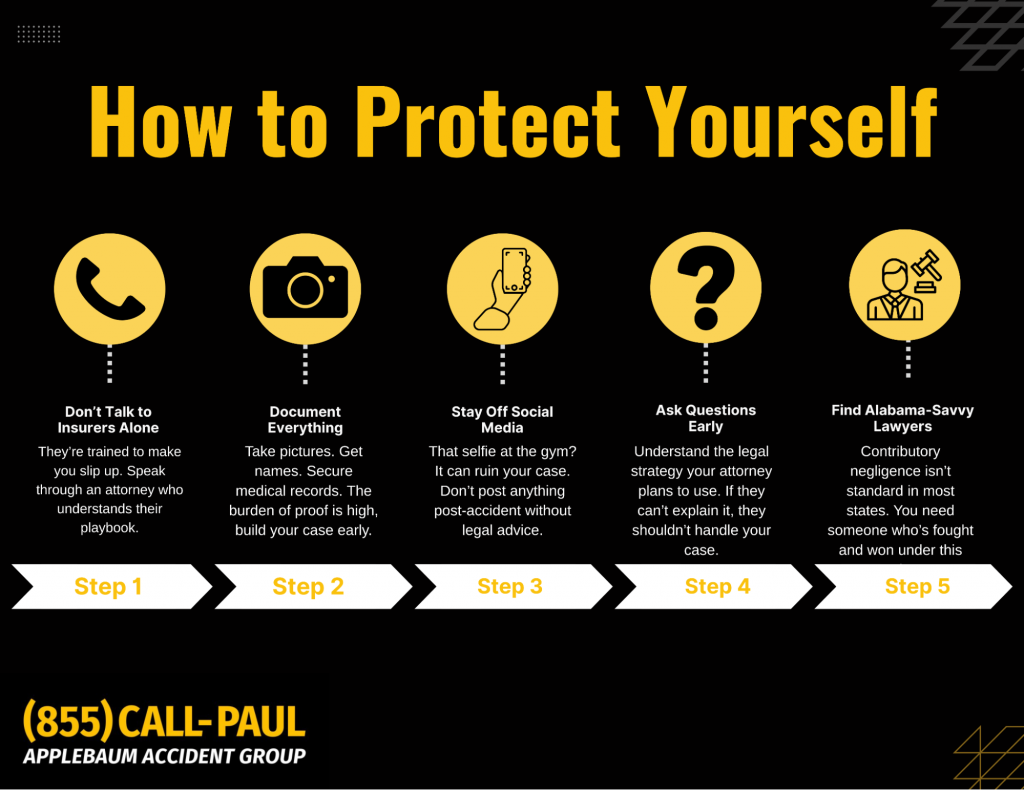
Alabama’s legal landscape doesn’t forgive small mistakes. Protecting yourself begins the moment an accident occurs:
- Don’t Talk to Insurers Alone: They’re trained to make you slip up. Speak through an attorney who understands their playbook.
- Document Everything: Take pictures. Get names. Secure medical records. The burden of proof is high, build your case early.
- Stay Off Social Media: That selfie at the gym? It can ruin your case. Don’t post anything post-accident without legal advice.
- Ask Questions Early: Understand the legal strategy your attorney plans to use. If they can’t explain it, they shouldn’t handle your case.
- Find Alabama-Savvy Lawyers: Contributory negligence isn’t standard in most states. You need someone who’s fought and won under this rule.
What People Often Don’t Realize
A major problem with Alabama’s system? Most people don’t even know this rule exists until it’s too late.
- Fault Threshold Confusion: Many think they’ll still receive partial compensation if they’re only a little at fault, not true in Alabama.
- False Confidence in “Common Sense”:People assume if the other party was clearly more negligent, they’ll win. But under this law, minor missteps erase claims.
- Slip and Falls Count Too: Yes, contributory negligence applies beyond car accidents. If you’re injured in a store but didn’t see a hazard sign, that could bar your case.
- Can You File in Another State? Sometimes, but jurisdiction is complex. You’ll need to speak with a local attorney who understands both your location and the law.
Don’t Let 1% Cost You Everything

Alabama’s pure contributory negligence law is designed to make injured victims feel helpless. And if you’re navigating this system alone, one word, one misstep, or one misinterpreted photo could destroy your claim.
But you don’t have to go it alone.
At Applebaum Accident Group, we’ve built an entire network around helping people like you, injured, overwhelmed, and at risk of being blamed for something you didn’t cause. We’re not a law firm, we’re your connection to attorneys who get Alabama’s 1% rule and know how to challenge it effectively.
Here’s how we help:
- Immediate Case Review: We’ll quickly connect you with a local attorney who knows how to build zero-fault narratives that hold up in court.
- Trusted Legal Network: Our referrals aren’t random, we match you with attorneys who have experience specifically handling pure contributory negligence cases in Alabama.
- Built-In Support: You don’t just get a name. You get a support system that understands medical, legal, and insurance challenges, all in one place.
If you’re worried about losing your case over a technicality, let’s change the outcome before it’s too late.
📞 855-225-5728 | Request An Appointment
👉 Reach out to Applebaum Accident Group today, and we’ll connect you with the kind of lawyer who doesn’t flinch at Alabama’s toughest rules.

